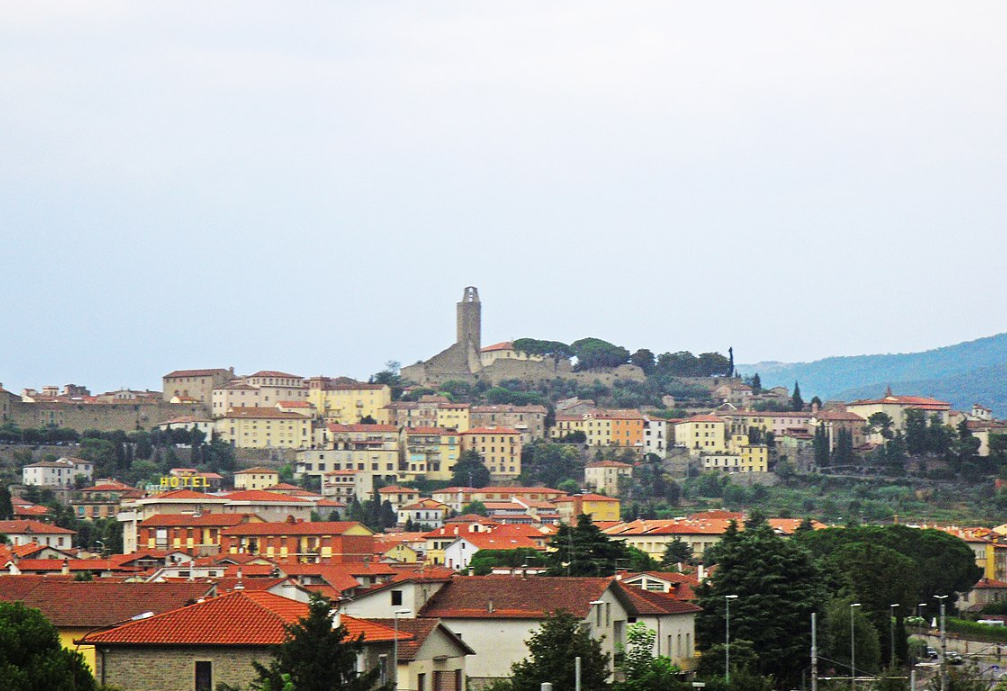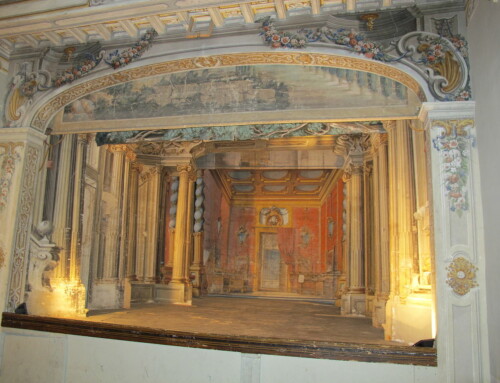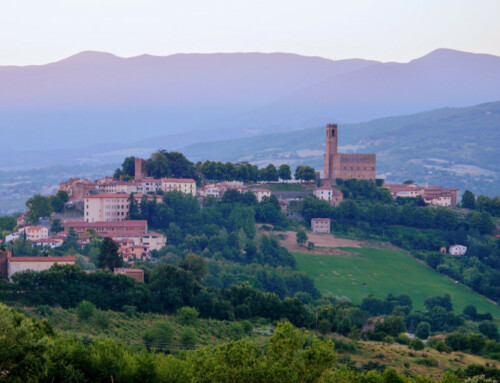Castiglion Fiorentino: a splendid medieval burgh

Castiglion Fiorentino is a medieval village situated on a hill 17 km southeast of Arezzo, surrounded by the fertile Valdichiana and the pre-Apennine heights. Of prehistoric origin, it flourished in Etruscan and Roman times. An important crossroads between Arezzo and Cortona, the village is rich in historic monuments, such as the Palazzo Comunale, the Cassero Tower, and the Vasarian Loggias. Today, Castiglion Fiorentino keeps traditions alive with events such as the Palio dei Rioni and local festivals, offering a unique experience of Tuscan history, culture and gastronomy.
Discovering Castiglion Fiorentino
Castiglion Fiorentino is a charming medieval village situated on a hill 342 meters above sea level, 17 kilometers southeast of Arezzo. This picturesque historic center is surrounded by a fascinating landscape that includes the fertile Valdichiana and the pre-Apennine heights. With its ancient walls, towers and historic buildings, Castiglion Fiorentino offers a journey through time, allowing visitors to immerse themselves in centuries of history. The village has a rich cultural and artistic tradition, with roots dating back to Etruscan and Roman times. In addition to its historical and architectural beauty, Castiglion Fiorentino is known for its lively local traditions, festivals and a typical Tuscan cuisine that delights palates. The village is a hidden treasure that preserves the authenticity of Tuscany, offering a unique experience to anyone wishing to explore Italian history and culture.
The Geography and Territory
Castiglion Fiorentino stands on a hill 342 meters above sea level, with panoramic views of the Valdichiana and the surrounding heights. Located 17 kilometers southeast of Arezzo, the municipal territory extends over the fertile alluvial plain of the Valdichiana and the hills that border it. To the east, it is bounded by the Pre-Apennines, while to the south and southwest it borders the municipalities of Cortona and Foiano della Chiana. The Canale Maestro della Chiana, along with other waterways such as the Canale di Montecchio and the Torrente Vingone, characterizes the hydrographic network of the area. Once a marshy and unhealthy region, as mentioned by Dante in Inferno, the Valdichiana has been reclaimed several times, making the land today particularly fertile and favorable for agriculture. The mountains in the area, though of modest altitude, were of strategic importance during the Middle Ages, housing numerous castles and fortifications.
Ancient History: From Prehistory to the Etruscans
Castiglion Fiorentino’s origins date back to prehistoric and protohistoric times, with evidence of human settlement as early as these periods. The village experienced an early period of flourishing during the Villanovan period and developed significantly in Etruscan times, between the sixth and fourth centuries B.C. Strategically located between the lucumonies of Arezzo and Cortona, Castiglion Fiorentino became an important commercial and cultural crossroads. Archaeological excavations in the area of the Cassero Tower have revealed remains of Etruscan structures and numerous artifacts, including the famous Brolio Deposit, discovered in the 19th century, which includes a large quantity of bronze figurines. The Etruscans brought significant land reclamation to the Val di Chiana, which was then crossed by the Clanis River, a navigable waterway crucial for trade. These artifacts testify to Castiglion Fiorentino’s prosperity and importance in antiquity, offering a fascinating glimpse into the village’s past.
Roman Period and Middle Ages
With the arrival of the Romans Castiglion Fiorentino exploited the fertility of the land to meet the food needs of the Urbe. In the Middle Ages, the village saw significant growth, with the construction of numerous castles and fortifications due to its strategic location. In the 10th century, Castiglione became a fief of the Marquises of Monte Santa Maria. The formation of the free commune began in the second half of the 12th century, but it was constantly opposed by neighboring towns. After Arezzo’s defeat at Campaldino in 1289, Castiglione came under the rule of Florence, marking the beginning of a new chapter in its history.
From the Renaissance to the Modern Age
During the Renaissance, Castiglion Fiorentino underwent major urban and social transformations. After several passages of domination between Florence, Arezzo and Perugia, in 1384 the village finally came under Florentine control, adopting the name “Castiglion Fiorentino.” This period saw significant interventions by figures such as Bishop Guido Tarlati, who enlarged the town walls and modified the urban structure. Under the Medici, the village experienced a period of stability and development. With the advent of the Lorraines in 1765, the area underwent further improvements, especially thanks to the reclamation of the Valdichiana conducted by engineer Vittorio Fossombroni under Grand Duke Peter Leopold. This reclamation transformed the marshy region into a fertile agricultural plain, fostering population growth and socio-economic changes. In 1774, an administrative reorganization incorporated the towns of Montecchio Vesponi, Mammi and Montanina into Castiglion Fiorentino, further consolidating the territory. T
Castiglion Fiorentino and the Wars
Castiglion Fiorentino went through numerous conflicts, leaving a deep mark on its history. During the war between Florence and the Sienese Republic, the town was taken by the condottiere Piero Strozzi, only to return under Florentine control in 1554. The town suffered devastation during the Black Death of 1348 and subsequent epidemics, which caused crises and famine. During the Napoleonic period, Castiglion Fiorentino was garrisoned by French troops from 1800 to 1814, with a brief interval of liberation by the “Viva Maria” insurgents. During World War II, the passage of the war front caused severe damage to the historic center and the municipal area. On December 19, 1943, an allied bombing caused the death of 71 civilians, mainly women and children. For this episode, Castiglion Fiorentino was decorated with the Silver Medal of Civil Merit in 2004, recognizing the community’s sacrifice and resilience during the conflict.
Monuments and Architecture of Castiglion Fiorentino
Castiglion Fiorentino is rich in historic monuments and architecture of great value, evidence of its long and varied history. Palazzo Comunale, erected in the 14th century during the Perugian rule, is one of the village’s most emblematic buildings. Cassero Tower, which dominates the town, stands on the ancient inhabited area and was rebuilt in the 14th century. The Praetorian Palace, dating from 1412, now houses the Municipal Library and the Archaeological Museum, which preserves Etruscan, Roman and medieval artifacts. The Vasarian Lodges, built in 1513 and later retouched by Giorgio Vasari, offer spectacular views of the Chio Valley. Among the religious buildings, the Collegiate Church of San Giuliano, built in the 19th century, and the 12th-century Church of Sant’Angelo al Cassero are particularly noteworthy. These monuments, along with others such as the Montecchio Vesponi Castle and the Montanina Castle, make Castiglion Fiorentino a place of great historical and cultural interest.
Religious Architecture
Castiglion Fiorentino is renowned for its many churches and religious buildings, which testify to its rich spiritual and artistic history. Collegiate Church of San Giuliano, built in the 19th century, houses works of art by artists such as Bartolomeo della Gatta and Lorenzo di Credi. 15th-century Pieve di San Giuliano is another architectural gem in the village. The Church of Sant’Angelo al Cassero, dating from the 12th century, is adorned with works by Giorgio Vasari. The Church of San Francesco, with its late 13th-century Romanesque-Gothic structure, houses a valuable “Saint Francis” by Margaritone d’Arezzo. Other important religious buildings include the Church of Our Lady of Consolation, attributed to Antonio da Sangallo the Younger, and the 14th-century Church of St. Augustine. In the municipal area, the Sanctuary of the Madonna del Bagno, built in the 16th century, is known for its healing water spring.
Culture and Traditions Today
Today Castiglion Fiorentino is a vibrant cultural center that keeps its ancient traditions alive and celebrates its rich history with a series of annual events and festivals. The town is known for the Palio dei Rioni, a historical competition held each June that involves the town’s three districts in competitions and celebrations reminiscent of the medieval period. Throughout the year, the town hosts numerous cultural events, including art exhibitions, concerts and theater performances, often held in the Municipal Theater, built in the late 19th and early 20th centuries. The Rificolona Festival, celebrated in September, is another local tradition that lights up the streets with colorful lanterns. Local gastronomy is central to Castiglion Fiorentino’s culture, with festivals and markets offering Tuscan specialties such as olive oil, wine, and typical Valdichiana products.
Reading Time: 6min
Table of Contents:
- Discovering Castiglion Fiorentino
- The Geography and Territory
- Ancient History: From Prehistory to the Etruscans
- Roman Period and Middle Ages
- From the Renaissance to the Modern Age
- Castiglion Fiorentino and the Wars
- Monuments and Architecture of Castiglion Fiorentino
- Religious Architecture
- Culture and Traditions Today




